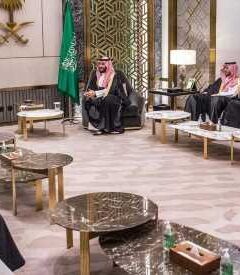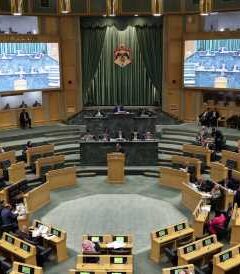Home » Middle East »
Iraqis Rise Against a Reviled Occupier: Iran
BAGHDAD — It started quietly a month or so ago with scattered protests. Those steadily expanded until last week more than 200,000 Iraqis marched in Baghdad, raging against the Iraqi government and a foreign occupier — not the United States this time, but Iran.
While the current leaders of the Iraqi government cower inside the Green Zone, where officials running the American occupation once sheltered, the protesters outside direct their anger against the Islamic Republic of Iran, which they now see as having too much influence.
“Free, free Iraq,” they shout, “Iran get out, get out.”
On the streets and in the squares of Iraq’s capital, in the shrine city of Karbala — where protesters on Sunday threw gasoline bombs at the Iranian Consulate — in back alleys and university hallways, a struggle is taking place over who will shape the country’s future. Iraq, along with Lebanon, another heavily Shiite country that has been roiled by protests, is part of a developing revolt against efforts by Shiite-dominated Iran to project its power throughout the Middle East
“The revolution is not anti-American, it is anti-Iran, it is anti-religion — anti-political religion, not religion as such,” said Saad Eskander, the former head of the Iraqi National Archives.
The protesters, he said, were fed up with corruption and the Shiite militias, some of which have evolved into mafias running extortion rackets. But more than that, he added, this is “a revolution with a social dimension. In Iraq, patriotism was always political, now it has a social justice component.”
While Iran is the immediate target of the protesters’ wrath, the fight is larger than that. It is a struggle between younger Iraqis and an older, more cautious generation, between a political elite and a rising cohort that rejects their leadership.
It is a struggle, above all, between those who have profited handsomely since the American invasion toppled Saddam Hussein, and those who are struggling to get by and look on with fury as the political parties, some with ties to Iran, distribute payoffs to the well connected.
“It was exactly 99 years ago that the last great Iraqi revolution took place, it was totally Iraqi born,” said Laith Kubba, an adviser to the government.
While the 1920 revolution was ultimately defeated, the sentiment that drove it, the rejection of foreign influence, remains embedded in the Iraqi psyche. A century ago the target was the British; in the early 2000s, it was the Americans that ran afoul of Iraqi nationalism; now it is Iran.
The system put in place after the 2003 invasion, although crafted by Iraqis and enabled by the Americans, enshrined a system of dividing political power along religious and ethnic lines. Iran exploited that framework, using it to embed itself in Iraqi politics.
As the United States retreated from Iraq after 2009, the Iranian-linked parties extended their networks inside the government. In 2014 when the Islamic State invaded, it was Iran that rushed to Iraq’s rescue, helping form militias to fight the militants and by 2018 becoming so powerful that political parties linked to Iran became the kingmakers in the government.
It was an influential Iranian general, Maj. Gen. Qassim Suleimani, the head of the Islamic Revolutionary Guards Corps, who brokered the deal that created the current government.
Meanwhile, at the grass-roots level and among the country’s young people, there was a growing sense that Iran was profiting at the expense of Iraq. While often exaggerated, the complaints have become part of the political backdrop to the protests.
“All of our budget goes to Iran to support” the Revolutionary Guards, said Ali Jassim, a construction worker, as he washed tear gas out of his eyes below the Jumhuriyah Bridge, where the demonstrations are focused.
“All the ministries, all the civilian facilities in Iraq are run by Iran,” he said, but, “still our passports are not good in almost any country. We want to get rid of this government, we want our country back, we want an independent president.”
“When we were growing up our parents said, ‘Shut up, the walls have ears,’” said Mohammed al-Amin, a second-year medical student who was working at one of the first aid stations, treating protesters suffering from tear gas and pepper spray exposure.
“But we have internet, we have traveled. We can see what the world is like and we want a different life. We want to be like the other countries, we want our rights,” he said.
The demands of the demonstrators — to get rid of corruption, end political parties, create a presidential system instead of a parliamentary one — seem at once reasonable and almost impossible to realize; at least, not without bloodshed.
It is all the more difficult to achieve since the demonstrators are increasingly demanding immediate results, as if they want to see the lawmakers and ministers pack their bags, slink out of their privileged villas in the Green Zone and vanish altogether.
Those politicians who would like to work with the protesters recognize that the fundamental changes they are demanding — new election laws, new elections and ultimately a new Constitution — cannot be achieved overnight. Their methodical approach, however, frustrates protesters who are impatient to see changes start now.
The Iraqi president, Barham Salih, is trying to take steps in that direction, introducing legislation that would eliminate the current system of party lists and allow voters to cast their ballots for individual candidates. But, in essence, he is asking Parliament to adopt a system that would cost many of its members their seats.
On Friday night, the largest crowds ever to gather in recent Iraqi history came to protest peacefully, but noisily, against the government, wreathing entire buildings in flags. Inside the Green Zone, the government’s guesthouse inside was as quiet as a library. The vast, marble-floored reception area was perfectly polished as a few men gathered on roomy couches to puzzle over the state of the country, while a waiter served tea and coffee. It was as if there was no rush at all.
The two places were physically just a mile apart but metaphorically in different worlds. It was hard to see how Iraqis would ever reconcile the anti-elite, anti-Iran, anti-party feelings in the street with the attitudes of those who have benefited from the system.
“There is the political level, the street and the security establishment, and each one of these groups is very occupied with themselves,” said Maria Fantappie, a senior analyst on Iraq at the International Crisis Group.
“The protesters, for instance, they celebrate the feeling of freedom and they feel empowered in the mood they created. Not just young males but also for the first time young females and other factions of the society,” she said.
But the protesters “are not looking at what might be the end goal,” she added. “They are celebrating that they have created this movement.”
Members of the political class, too, are talking largely to one another and not to the protesters — and often blaming one another for the current situation. The Parliament has met just once or twice to discuss legislation that might respond to the demonstrators’ demands.
“They are playing for time,” said Mr. Eskandar, the former head of the National Archives, noting that most politicians are still hoping that the protests will blow over.
Prime Minister Adel Abdul Mahdi has drawn criticism for allowing security forces to try to suppress the protests with force. During the first week of October nearly 150 protesters died, a vast majority shot to death, and some 5,500 people, including more than 1,000 members of the security forces, were wounded, according to a government investigation into the incident.
That miscalculation drew tens of thousands more people to the protests. The gatherings have exploded into the range of 20,000 to 25,000 in cities nationwide to close to 200,000 in the capital. And violence flared again on Monday, when the security forces fired into demonstrators as they sought to cross Al Ahrar Bridge in Baghdad, killing at least five.
The prime minister, while the target of much criticism, has taken steps to improve the lives of Iraqis, expanding and solidifying the electricity supply, improving relations with Iraq’s Kurds and removing the blast walls that had divided much of Baghdad. But he remains a weak leader who owes his position to a political deal crafted largely by Iran but also acceptable to Washington.
So while Mr. Mahdi has managed to place technocrats in the electricity and oil ministries, Iranian-linked parties dominate at least five major ministries, including those of the interior, communications and labor and social affairs. That gives them access to thousands of patronage jobs, contracts and grants, and breeds the corruption that the protesters are condemning.
The corruption by now is endemic, and present even in those ministries viewed as well run.
“I graduated in engineering, but when I applied for a job at the Ministry of Oil they asked for $7,500,” said Muhaiman Fadil, 30. Now, he says, “I work freelance in construction.”
On Friday in Tahrir Square in Baghdad, the center of the protests, young men put up a white banner with red Xs drawn through photographs of Ali Khamenei, Iran’s supreme leader, and General Suleimani.
The security forces themselves are divided several times over: between lower-level officers and more senior ones; between those with the Defense Ministry and those with the Interior Ministry, which includes brigades close to Iran; and other, smaller schisms.
These divisions led to differences among security entities over how to confront the protesters, who had taken over a building that looms over the Jumhuriya Bridge. The army refused to agree to a plan to clear the building, even though it afforded the protesters an ideal perch for tossing gasoline bombs in support of their fellow protesters’ quest to cross the bridge and reach the Green Zone.
Army officers feared further bloodshed that would ignite even greater protests. “There is no need to make this big problem by going in,” said a senior military official, speaking of the proposed plan to clear the building. “You cannot imagine what the reaction would be.”
Iraqi news channels announced at midnight Monday that the government had shut down the internet. There was no explanation, but officials also shut it down in early October, when they believed the protests were getting out of control.
Though the government gradually restored internet service, social media services including Facebook, Twitter, and WhatsApp have been blocked throughout the protests.
It remains unclear how long the protesters will remain in the streets. For those who go every day with flags around their necks, like Abu Jamal, 40, a baker, the answer for those who come to Tahrir Square every day is that they will stay as long as it takes.
“I can demonstrate for a day, two days, a week, a year, 500 years,” said Mr. Jamal,
Falih Hassan contributed from Baghdad.
Source: Read Full Article


